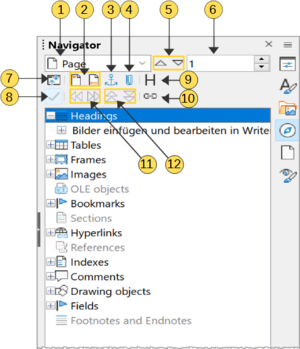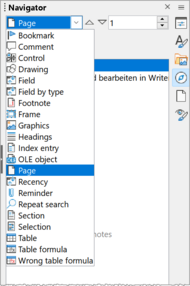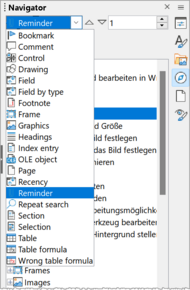Using the Navigator in Writer
TDF LibreOffice Document Liberation Project Community Blogs Weblate Nextcloud Redmine Ask LibreOffice Donate
Foreword
The video shows how you can "Using the Navigator in Writer - LibreOffice" and refers to this page here for more information and details.
This description is based on the documentation Writer Guide 7.2; Chapter 1; Using the Navigator [EN].
Link to the Video
Link to the Video (in German [DE]):
Verwendung des Navigators in Writer – LibreOffice
In a default installation of LibreOffice, the Navigator is part of the Sidebar.
The Navigator lists all of the headings, tables, text frames, graphics, bookmarks, and other objects contained in a document.
-
Navigator
To open the Navigator, do one of the following:
- Click the “Navigator”
 icon in the Tab bar on the right of the Sidebar.
icon in the Tab bar on the right of the Sidebar. - Click the Navigator icon (if visible) on the “Standard” toolbar.
- Press F5.
- Choose ▸ on the menu.
Click the ![]() sign or triangle to the left of a category or subcategory to display its contents.
sign or triangle to the left of a category or subcategory to display its contents.
Summarizes the functions of the icons at the top of the Navigator.

| Nr | Funktion | Beschreibung |
|---|---|---|
| 1 | Navigate By | Opens a drop-down list where you can select the type of element by which you want to navigate. |
| 2 | Header / Footer | Jumps between the text area and the header or footer area (if the page has them). |
| 3 | Anchor <–> Text | Jumps between a footnote anchor and the corresponding footnote text. |
| 4 | Set Reminder | Inserts a reminder. See "Setting Reminders". |
| 5 | Previous page / Next page | Jumps to the previous / next element of the type selected in the Navigate By drop-down list. |
| 6 | Go to Page | Jumps to the page number shown in the box. Type a page number or select it using the + and – signs. |
| 7 | Content Navigation View | Switches between showing all categories and showing only the selected category. |
| 8 | List Box On / Off | Toggles between having the list box shown or hidden. |
| 9 | Heading Levels Shown | Choose the number of heading levels to be shown. |
| 10 | Drag Mode | Select Insert as Hyperlink, Link, or Copy. See Chapter 3, Working with Text: Advanced1). |
| 11 | Promote Level / Demote Level | Quickly change the level of the selected heading in the document. See Chapter 3, Working with Text: Advanced1). |
| 12 | Promote Chapter / Demote Chapter | Move headings and text in the document. See Chapter 3, Working with Text: Advanced1). |
1) Chapter 3, Working with Text: Advanced

The Navigator provides several convenient ways to move around a document and find items in it:
- To jump to a specific page in the document, type its sequence number in the box at the top of the Navigator and press Enter. The sequence number may be different from the page number if you have restarted numbering at any point (if the entered page number is greater than the last page, it will jump to the last page).
- When a category is opened to show the list of items in it, double-click an item to jump directly to that item’s location in the document. For example, you can jump directly to a selected heading, graphic, or comment by using this method.
- To see the contents in only one category, highlight that category and click the Content Navigation View icon. Click the icon again to display all the categories. You can also change the number of heading levels shown when viewing Headings.
- Use the Previous and Next icons to jump to other objects of the type selected in the Navigate By drop-down list.
- In the top left of the Navigator is a Navigate By drop-down list. You can pick a type of object (such as a bookmark, table, or index entry) and then use the Previous (^) and Next (v) buttons to jump from one to the next. See Figure "Navigate By" drop-down list.
Setting Reminders

Reminders let you mark places in your document that you want to return to later on, for example to add or correct information or simply mark where you finished editing.
The possible uses of reminders are limited only by your imagination.
To set a reminder at the cursor’s current location, click the Set Reminder icon in the Navigator.
You can set up to 5 reminders in a document; setting a sixth causes the first to be deleted.
Reminders are not highlighted in any way in the document, nor are they listed in the Navigator.
So you cannot see where they are, except that when you jump from one to the next, the location of the cursor shows the location of the reminder.
To jump between reminders, first select the Reminder option in the “Navigate By” drop-down list.
Then click the “Previous Reminder” or “Next Reminder” icons.
Reminders are not saved with the document.
Further Informations
Documentation / Manuals
Here you will find the Documentation / Manuals:
Any questions?
For questions on this topic go to:
Get Involved
Join us today and help us to make it even better!
Donate
LibreOffice is Free Software and is made available free of charge.
Your donation, which is purely optional, supports our worldwide community.
If you like the software, please consider a Donation.
